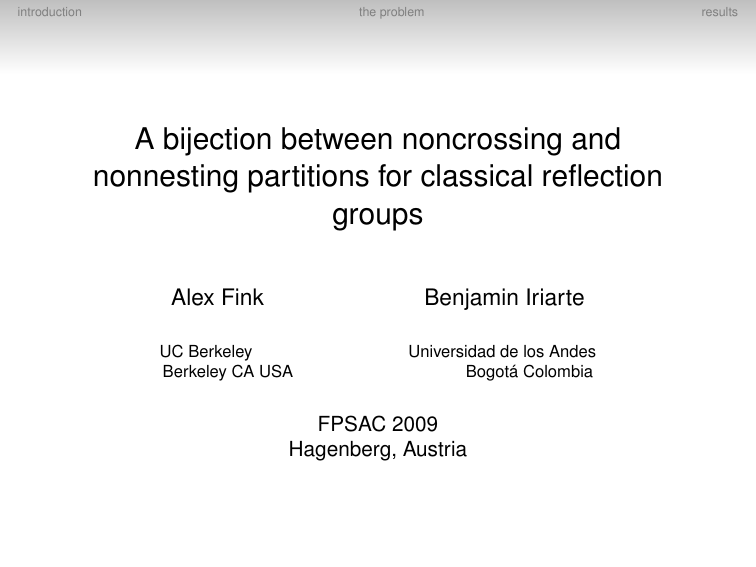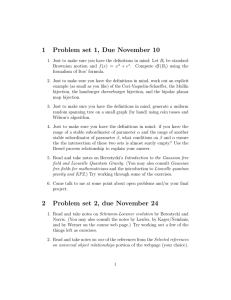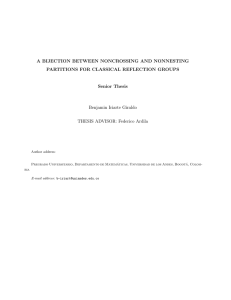A bijection between noncrossing and nonnesting partitions for classical reflection groups Alex Fink
advertisement

introduction
the problem
A bijection between noncrossing and
nonnesting partitions for classical reflection
groups
Alex Fink
Benjamin Iriarte
UC Berkeley
Berkeley CA USA
Universidad de los Andes
Bogotá Colombia
FPSAC 2009
Hagenberg, Austria
results
introduction
the problem
results
some definitions
A finite reflection group is a finite group
of operators in Rn generated by
reflections.
When not specified, W will be assumed
to be a classical Weyl group with
standard coordinatization.
Let Φ be a nonempty finite set of
nonzero vectors in Rn such that for all
α∈Φ
NN(W ):
A (uniform) nonnesting partition for a
Weyl group W is an antichain in the root
poset of W .
(R1) Φ ∩ αR = {α, −α}
(R2) tα Φ = Φ
Then Φ is called a root system and its
elements are called roots. Every total
order on Rn partitions Φ into positive
roots Π(> 0) and negative roots −Π.
Recall, in the set of positive roots Π of
W , we say α < β if β − α is in the
nonnegative span of the simple roots,
α, β ∈ Π.
Each positive system Π contains exactly
one subset ∆ which is a basis for
span(Φ) and such that Π is in the
R≥0 -span of ∆.
NC(W ):
Relative to any standard Coxeter
element c, the poset of (uniform)
noncrossing partitions is the interval
NC(W , c) = [1, c].
Reflection groups give rise to root
systems and viceversa.
Does not depend on the choice of c.
introduction
the problem
results
How are these definitions equivalent to these diagrams?:
14
13
12
11
10
9
8
7
6
5
4
3
2
1
14
13
12
11
10
9
8
7
6
5
4
3
2
1
introduction
the problem
results
We say that Φ is crystallographic if in
addition it satisfies a third condition
(R3)
2hα,βi
hβ,βi
∈ Z for all α, β ∈ Φ.
d
−4
A reflection group W arising from a
crystallographic root system Φ is called
a Weyl Group of Φ.
−3
−4
−2
−3
−1
1
2
3
4
5
0
−4
2
3
−1
4
u
−3
−2
1
−2
1
2
3
−11 2
4
3
4
Weyl groups are exactly the finite
reflection groups which stabilize the
Z-span of some basis for Rn (a lattice
isomorphic to Zn ).
The root poset of W is its set of positive
roots Π with the partial order ≤ under
which, for β, γ ∈ Π, β ≤ γ just if
γ − β lies in the nonnegative integer
span of the simple roots.
Let W be a finite reflection group with
associated simple system
∆ = {α1 , α2 , . . . , αm }. A standard
Coxeter element of W is any element of
the form c = tα
tα
. . . tα
,
σ(1)
σ(2)
(1234)
(123)
(124)
(1243)
(134)
(12)
(1324)
(1342)
(234)
(12)(34)
(13)(24)
(13)
(14)
(23)
σ(m)
where σ is a permutation of the set dme.
(1)
(1423)
(14)(23)
(24)
(132)
(1432)
(142)
(34)
(143)
(243)
introduction
the problem
the context
For each Weyl group W we have
|NN(W )| = |NC(W )|
Moreover, when W = An−1 we have
|NN(W )| = |NC(W )| = Cn , the classical Catalan number.
The Coxeter-Catalan combinatorics.
• What is the nature of the connection between these sets?
• Why are they equicardinal?
An impressive and mind-opening result on the matter by
Athanasiadis and Reiner (2004).
results
introduction
the problem
results
additional background
The partition lattice
P(W ) of W is the
collection of
intersections of
reflecting hyperplanes
\
{
α⊥ : S ⊆ Π}
α∈S
ordered by
reverse-inclusion of
subspaces.
Let A be an antichain of
the root poset of W , ie.
let A ∈ NN(W ). Then,
the fixed space Fix(A) of
A is the set Fix(π
Q A ),
where πA = α∈A tα
with the product taken in
any order.
This is a good definition!
introduction
the problem
Consider the injections from
NC(W ) to P(W ) and from
NN(W ) to P(W ) which
respectively take w 7→ Fix(w)
and A ; Fix(A), and the map
results
Theorem
(Athanasiadis,
Reiner)
Letting
f : NC(W ) 7→ P(W ) ,→ P(W )/W
P(W ) ,→ P(W )/W
g : NN(W ) ; P(W ) ,→ P(W )/W
U ,→ {w(U)|w ∈ W }
that sends vector subspaces
of the partition lattice to their
W -orbits or W -conjugacy
class.
Then, for each W -orbit
O ∈ P(W )/W , we have
|f −1 (O)| = |g −1 (O)|.
This is the beginning of the
mystery...
introduction
the problem
the problem
• Find a bijection between noncrossing and nonnesting partitions of Weyl
groups which refines the theorem of Athanasiadis and Reiner, the more
uniform and conceptual the bijection is, the better.
Several very interesting efforts in this direction have been done recently by C.
Stump and R. Mamede.
• We found a uniform bijection (up to the choice of the standard
coordinatization) between these sets for classical groups.
Good things: There are only a very small finite number of exceptional groups
left to check, the realization of both NN and NC partitions through some
statistics which characterize them completely (therefore unifying the
concepts), the bijection is elementary.
To be done: The conceptual connection between these sets is still missing,
we have just described how that hidden concept presents itself (or maybe not
even that).
results
introduction
the problem
results
the plan
• Use the bump diagrams
representation for the classical partitions
of W to find the connection.
Consider some U ∈ P(W ) and let ρU
be the orthogonal projection of Rn on U.
The operator ρU induces a partition of
the set
• Why do we care about bump
diagrams?:
The map U 99K Part(U) is a bijection
between P(W ) and Part(W ), so then
the maps
E = {±ei : i = 1, . . . , n}
f
into fibers, by which a, b ∈ E belong to
the same block if and only if
ρU (a) = ρU (b). We denote this
partition by Part(U). Any partition of E
induced in this way is called a classical
partition of W . Denote the set of
classical partitions of W by Part(W ).
Streaming the notation of classical
partitions by writing ±i for ±ei , classical
partitions for W can be also realized as
partitions of
±dne = {1, . . . , n, −1, . . . , −n} for
some n, which we draw in bump
diagrams.
NC
f
: w 7→ Fix(w) 99K Part(Fix(w))
NN
: A ; Fix(A) 99K Part(Fix(A))
are injective maps of NC(W ) and
NN(W ) into Part(W ).
This is good, we can now compare the
objects directly using bump diagrams,
which are nice noncrossing and
nonnesting graphs if we choose the right
ground sets.
introduction
the problem
results
By choosing the right ground sets, we can make them look like
this:
8
7
6
5
4
3
2
1
4
3
2
1
0 −1 −2 −3 −4
1
4
3
2
1 −1 −2 −3 −4
4
3
2 −1 −2 −3 −4
Figure: Examples of nonnesting bump diagrams in (top) A7 , B4 ;
(bottom) C4 , D4 .
introduction
the problem
case-by-case results
type A
Let π be a classical partition for An−1 . Let M1 <lp · · · <lp Mm be
the blocks of π, and ai the least element of Mi , so that
a1 < · · · < am . Let µi be the cardinality of Mi . Define the two
statistics a(π) = (a1 , . . . , am ) and µ(π) = (µ1 , . . . , µm ).
Theorem (Athanasiadis)
The statistics (a, µ) establish a type-preserving bijection for
An−1 .
results
introduction
the problem
results
8 7 6 5 4 3 2 1
8 7 6 5 4 3 2 1
1
8 7 6 5 4 3 2 1
2 1
8 7 6 5 4 3 2 1
4 3 2 1
8 7 6 5 4 3 2 1
Figure: type A NN-NC with a = (1, 2, 4), µ = (2, 3, 3).
introduction
the problem
results
9 8 7 6 5 4 3 2 1
9 8 7 6 5 4 3 2 1
1
9 8 7 6 5 4 3 2 1
21
9 8 7 6 5 4 3 2 1
543
21
9 8 7 6 5 4 3 2 1
6 543
21
9 8 7 6 5 4 3 2 1
Figure: type A NC-NN with a = (1, 2, 5, 6), µ = (3, 2, 3, 1).
introduction
the problem
A characterization:
Corollary (Fink, I.)
Suppose we are given a pair of tuples of positive integers
a = (a1 , ..., am1 ), µ = (µ1 , ..., µm2 ) and let n > 0. Define a0 = 0
and µ0 = 1. Then, a and µ represent a classical noncrossing or
nonnesting partition for An−1 if and only if
1. m1 = m2 = m;
P
2. n = m
k =1 µk ; and
P
3. ai−1 < ai ≤ ki−1
=0 µk for i = 1, 2, ..., m.
results
introduction
the problem
type C
A positive block of a classical partition π is a block of π that contains some positive
integer; similarly a negative block contains a negative integer. A switching block of π is
a block of π that contains both positive and nonpositive elements, and a nonswitching
block is one that contains only nonpositive elements or only nonnegative elements.
Let π be a classical partition for Cn . Given π, let M1 <lp · · · <lp Mm be the positive
nonswitching blocks of π, and ai the least element of Mi . Let µi be the cardinality of Mi .
These two tuples are reminiscent of type A. Let P1 <lp · · · <lp Pk be the switching
blocks of π, let pi be the least positive element of Pi , and let νi be the number of
positive elements of Pi . Define the three statistics a(π) = (a1 , . . . , am ),
µ(π) = (µ1 , . . . , µm ), ν(π) = (ν1 , . . . , νk ).
results
introduction
the problem
Theorem (Fink, I.)
The statistics (a, µ, ν) establish a type-preserving bijection for
Cn .
A characterization:
Corollary (Fink, I.)
Suppose we are given some tuples of positive integers
a = (a1 , ..., am1 ), µ = (µ1 , ..., µm2 ), ν = (ν1 , ..., νk ) and let n > 0.
Define a0 = 0 and µ0 = 1. Then, a, µ and ν represent a
classical noncrossing or nonnesting partition for Cn if and only if
1. m1 = m2 = m;
P
Pk
2. n = m
i=1 µi +
j=1 νj ;
Pi−1
P
3. ai−1 < ai ≤ k =0 µk + kj=1 νj for i = 1, 2, ..., m.
results
introduction
the problem
8 7 6 5 4 3 2 1 −1 −2 −3 −4 −5 −6 −7 −8
8 7 6 5 4 3 2 1
8 7 6 5 4 3 2 1
8 7 6 5 4 3 2 1
8 7 6 5 4 3 2 1
3 2 1
8 7 6 5 4 3 2 1
4 3 2 1
8 7 6 5 4 3 2 1
8 7 6 5 4 3 2 1 −8 −7 −6 −5 −4 −3 −2 −1
8 7 6 5 4 3 2 1 −8 −7 −6 −5 −4 −3 −2 −1
Figure: type C NN-NC with a = (3, 4), µ = (2, 1), ν = (2, 3).
results
introduction
the problem
8 7 6 5 4 3 2 1 −8 −7 −6 −5 −4 −3 −2 −1
8 7 6 5 4 3 2 1
8 7 6 5 4 3 2 1
8 7 6 5 4 3 2 1
8 7 6 5 4 3 2 1
8 7 6 5 4 3 2 1
1
8 7 6 5 4 3 2 1
54 3 2 1
8 7 6 5 4 3 2 1
8 7 6 5 4 3 2 1 −1 −2 −3 −4 −5 −6 −7 −8
8 7 6 5 4 3 2 1 −1 −2 −3 −4 −5 −6 −7 −8
Figure: type C NC-NN with a = (1, 5), µ = (2, 1), ν = (1, 2, 2).
results
introduction
the problem
type B
The bijection for this type is exactly like the one for type C, but
we should be careful with zero blocks. Type B statistics are
characterized in the same way as those for type C.
results
introduction
the problem
results
type D
Refer to the arXiv or my undergraduate thesis. Tricky
generalization of the previous types.
Idea: Transform Dn -partitions into Bn−1 -partitions but keep track
of the lost information, then run the type B bijection and use the
lost data to recover a type D partition.
We can characterize these statistics as well.
1
10 9
4
8
7
3
6
2
5
−10
5
6
4
−9
1
−1
7
8
9
10 −2 −3
2 −1 −2 −3 −4 −5 −6 −7 −8 −9 −10
3
−4
4
−8
2
−10
5
−7
6
−6
7
−5
3
−9
−8
−7
−6
8
9
10 −2 −3
−4
−5
introduction
the problem
main theorem
We may unify all four bijections into one single statement using
the fixed spaces, the canonical basis of Rn and a lexicographic
order in Zn . For each NC(W ) [resp. NN(W )] partition x we
build a set Ωx ⊆ Fix(x) ∩ {1, 0, −1} and we define a constant
Γx ∈ {1, . . . , n} which completely characterize x and exactly
one y ∈ NN(W ) [resp. y ∈ NC(W )].
results
introduction
the problem
Let Ψn be the set of n-tuples with entries in {1, 0, −1}. For any u ∈ Ψn define #(u, 1)
to be the number of entries equal to 1 in u and define #(u, −1) analagously. Let <lex
be the lexicographic order on n-tuples. For any two vectors a, b ∈ Zn , let a be the set of
elements of Zn <lex -less than or equal to a and let
ka − bk = (|a1 − b1 |, . . . , |an − bn |).
To any NN or NC partition x of W we associate a set Ωx which is constructed
inductively with i increasing from 1 to n stepwise. Initially, we begin with Ωx = ∅. In
step i, let ui be the element of Ψn ∩ Fix(x) with kei − ui k <lex -minimal (actually
kei − ui k ∈ Ψn ). Whenever ui is linearly independent with the elements of Ωx , let
Ωx = Ωx ∪ {−ui } if ui has some entry −1 and let Ωx = Ωx ∪ {ui } if not. Let Γx be the
number of canonical coordinate projections of Fix(x) with trivial image {0}.
Lastly, let E be the canonical basis of Rn .
results
introduction
the problem
Theorem (Fink, I.)
Let x ∈ NN(W ) [resp. x ∈ NC(W )]. Then, there is a unique y ∈ NC(W ) [resp.
y ∈ NN(W )] for which Γx = Γy and such that the sets Ωx and Ωy are related to each
other in the following way:
There is a bijection σ between Ωx and Ωy such that for each u ∈ Ωx we have
σ(u) ∈ Ωy satisfying
•
•
•
•
#(u, 1) = #(σ(u), 1) and #(u, −1) = #(σ(u), −1)
card(u ∩ E) = card(σ(u) ∩ E)
card(u ∩ Ωx ) = card(σ(u) ∩ Ωy )
the product of the first two nonzero components of u and σ(u) is not equal
whenever #(u, −1) > 1 and #(u, 1) > 0
Consequently, the induced mapping establishes a bijection between noncrossing and
nonnesting partitions preserving orbital type.
The theorem works for the exceptional group G2 with (1, −1, 0) and (−2, 1, 1) chosen
as simple roots. What about the other exceptional types?
results
introduction
Thank you!!!
the problem
results
If interested, please look at:
http://arxiv.org/abs/0810.2613
http://math.sfsu.edu/federico/Articles/benjamin.pdf








